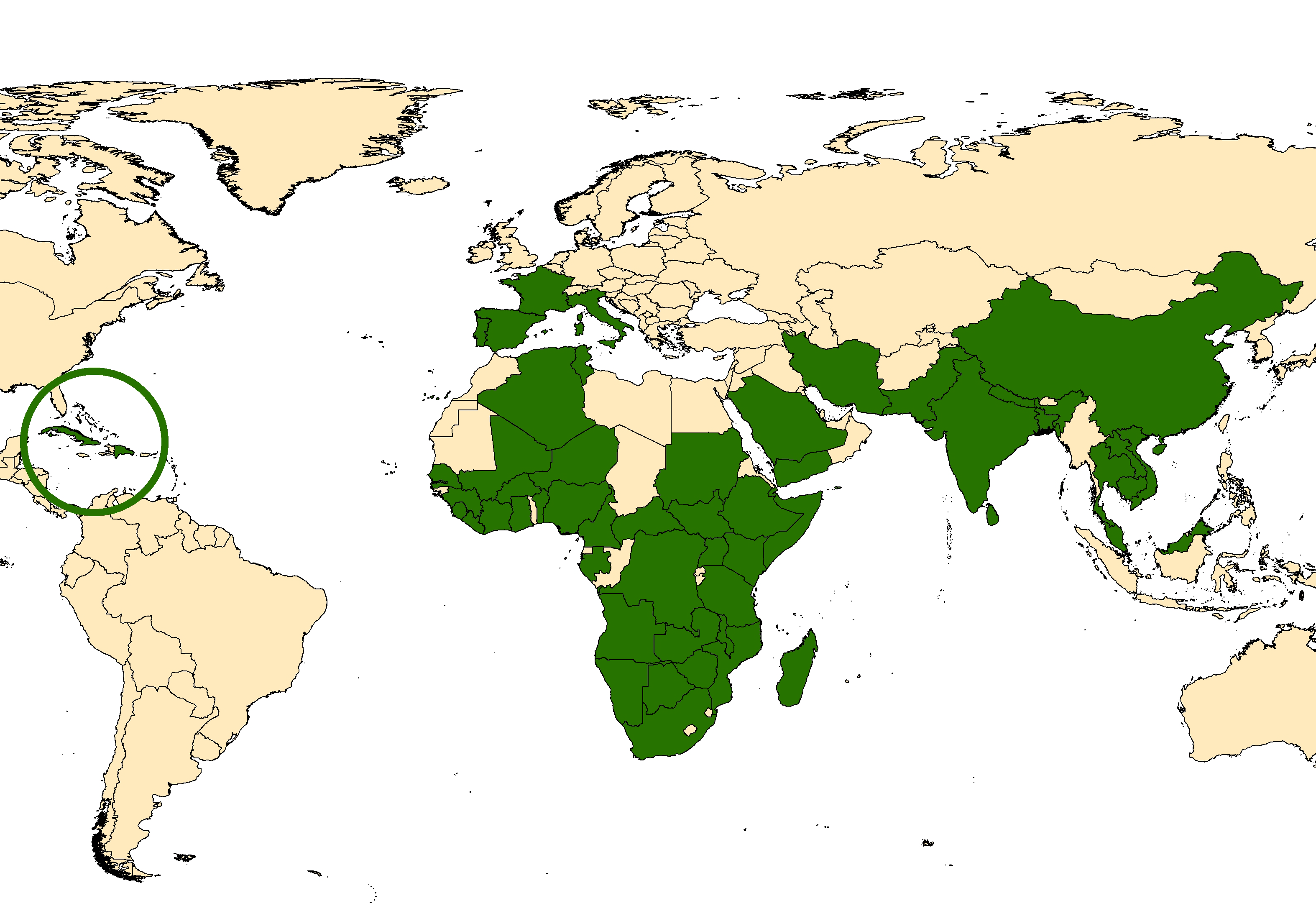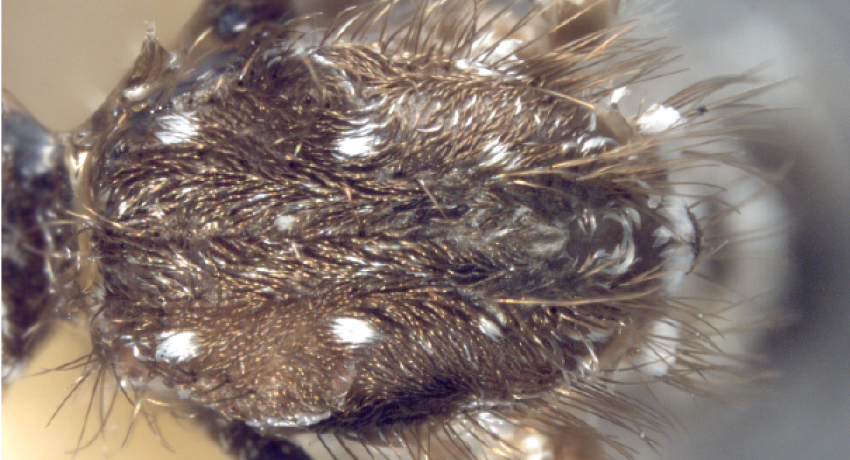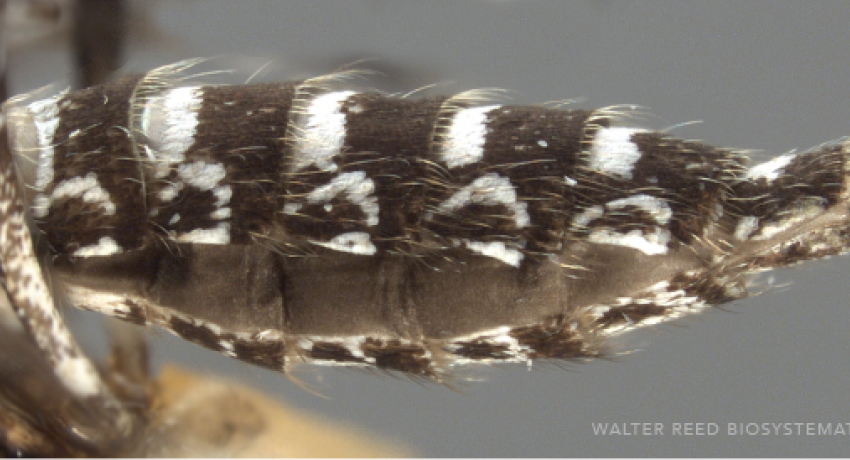PALEARTIC, ORIENTAL, & NEOTROPICAL REGIONS
Etymology: bound with ribbon or band (L); white ring on tibiae.
Type locality: Corsica
Type depository: Type non-existent (NE)
DIAGNOSTIC CHARACTERS (Click photos to view; mouse over and click large photo to zoom in.)
ADULT (illustrated): Head: Proboscis dark with median spattering of pale yellowish scales; clypeus with bilateral small patches of narrow white scales; vertex with median stripe of narrow white scales, a few of which are also scattered on occiput area and along eye margin; numerous erect forked scales on vertex and occiput. Thorax: Mesopostnotum and prespiracular area bare; postspiracular and lower mesepimeral setae present. Scutum: Acrostichal setae present; 3 pairs of distinct, small, white spots of narrow scales on anterior two-thirds of scutum (on scutal fossa, posterior scutal fossa and approximately level with the wing root). Scutellum: Broad white scales on all three lobes; a few dark scales at apex of mid-lobe. Wing: Scales mainly dark and narrow on all veins; scattered pale scales on costa. Abdomen: Tergum I (Te-I) with large median white spot; Te-II–VII with basal white bands and lateral white curved markings, disparate from the basal bands; segment VIII completely retracted. Legs: All tibia (Ti-I–III) dark, with sub-basal white spot and white band approximately level with basal third of Ti-I, Ti-II, and at mid-point of Ti-III (anterior view); hind tarsomeres 1–4 (Ta-III1–4) with basal white bands; ratio of white bands to length Ta-III1 = 0.40, Ta-III2 = 0.40, Ta-III3 = 0.50, Ta-III4 = 0.75; Ta-III5 all white.
TAXONOMIC KEYS
Darsie & Pradhan 1990
Jupp 1996
Rattanarithikul et al. 2010
Becker et al. 2010: 196
DISTRIBUTION NOTES
Algeria, Angola, Bangladesh, Benin, Botswana, Burkina Faso, Cambodia, Cameroon, Central African Republic, Comoros, Cote d'Ivoire, Cuba, Democratic Republic of the Congo, Djibouti, Dominican Republic, Ethiopia, France (includes Corsica), Gabon, Gambia, Ghana, Guinea, India, Iran, Italy (includes Sardinia), Kenya, Laos, Liberia, Madagascar (includes Glorioso & Juan De Nova Is), Malawi, Malaysia, Mali, Mozambique, Namibia, Nepal, Niger, Nigeria, Pakistan, People's Republic of China, Portugal, Republic of South Africa, Saudi Arabia, Senegal, Sierra Leone, Somalia, Spain (includes Balearic Islands), Sri Lanka, Sudan & South Sudan, Tanzania, Thailand, Tunisia, Uganda, Vietnam, Yemen, Zambia, Zimbabwe.

IMPORTANT REFERENCES
Bigot 1861: 227 (F; Culex)
Patton 1905 (E*, as subg. Stegomyia)
Theobald 1907: 199 (E bionomics), as Scutomyia sugens
Theobald 1910c (M*, F, L*,E*; after Patton 1905), as Scutomyia sugens)
Macfie & Ingram 1922 (F*)
Barraud 1923h (L*)
Barraud 1934: 245 (M*, F*, L*)
Edwards 1941: 155 (M*, F, *), 391 (P*)
Hopkins 1952: 160 (L*)
Mattingly 1952: 291 (zoogeography)
Senevet & Andarelli 1954b: 320 (L*)
Mattingly & Knight 1956: 100 (L*; taxonomy)
Senevet & Andarelli 1958: 273 (P*)
Boorman 1961: 709 (bionomics)
Joshi et al. 1965 (distribution; Nepal)
Hinton & Service 1969 (E*)
Mattingly 1970g: 35 (L*)
Service 1970c: 128 (M*, F*, P*, L*)
Aslamkhan 1971b (distribution; Pakistan)
Sharma & Chaudhry 1974: 163 (as variant)
Huang 1977b: 114 (M*, F*, P*, L*; transfer; distribution)
Brunhes 1977a (distribution; Comoros Island)
Rodhain et al. 1977 (distribution)
Ahmed 1987 (distribution; Bangladesh)
Zaim 1987: 568 (distribution)
Darsie & Pradhan 1990 (F, L; taxonomy, keys, bionomics, distribution; Nepal)
Suleman et al. 1993 (distribution; Pakistan)
Jupp 1996 (F*; key)
Reinert 2000e (F*)
Reinert 2000e: Fig. 21 (F*)
Ribeiro et al. 2002 (distribution; Portugal)
Melero-Alcíbar 2006 (P, taxonomy)
Rattanarithikul et al. 2010 (F*, L*; bionomics, keys; distribution; Thailand)
Becker et al. 2010: 196 (M*, F*, L*; keys, taxonomy, distribution, bionomics)
Robert et al. 2019 (distribution, Euro-Mediterranean)
Pagac et al. 2020 (invasive distribution, New World; Cuba, Dominican Republic)
CURRENT SYNONYMS
syn. brumpti Neveu-Lemaire
1905b: 9 (M, F*; Stegomyia) Type locality: Harrar [Hararge], Ethiopia (PIP). References: Rodhain & Boutonnier 1985: 275 (type dep. from NE to PIP).
syn. albopunctata Theobald
1907: 262 (F; Reedomyia). Type locality: Sierra Leone (NHMUK)
CURRENT SUBSPECIES
None
CITED REFERENCES
Ahmed, T.U. (1987). Checklist of the mosquitoes of Bangladesh. Mosquito Systematics, 19(3), 187–200.
Alarcón-Elbal, P. M., Rodríguez-Sosa, M. A., Newman, B. C., & Sutton, W. B. (2020). The First Record of Aedes vittatus (Diptera: Culicidae) in the Dominican Republic: Public Health Implications of a Potential Invasive Mosquito Species in the Americas. Journal of Medical Entomology, 57(6), 2016–2021.
Aslamkhan, M. (1971b). The mosquitoes of Pakistan. I. A checklist. Mosquito Systematics, 3(4), 147–159.
Barraud, P.J. (1923h). A revision of the culicine mosquitoes of India. Part VI. Some Indian species of the genus Finlaya Theo. adult stage. Indian Journal of Medical Research (Calcutta), 11(2), 475–493.
Barraud, P.J. (1934). The fauna of British India, including Ceylon and Burma. Diptera: Vol. 5. Family Culicidae, tribes Megarhinini and Culicini. London, England: Taylor and Francis.
Becker, N., Petrić, D., Zgomba, M., Boase, C., Madon, M., Dahl, C., & Kaiser, A. (2010). Mosquitoes and their control (2nd ed.). Berlin, Germany: Springer-Verlag.
Bigot, J. (1861). Trois diptéres nouveaux de la Corse. Annales de la Société Entomologique de France, 1, 227–229.
Boorman, J.P.T. (1961). Observations on the habits of mosquitos of Plateau Province, Northern Nigeria, with particular reference to Aedes (Stegomyia) vittatus (Bigot). Bulletin of Entomological Research, 52(4), 709–725.
Brunhes, J. (1977a). Les moustiques de l’archipel des Comores. I. Inventaire, répartition et description de quatre espèces ou sous-espècies nouvelles. Cahiers ORSTOM. Série entomologie médicale et parasitologie, 15(2), 131–152.
Darsie, R.F., Jr., & Pradhan, S.P. (1990). The mosquitoes of Nepal: Their identification, distribution and biology. Mosquito Systematics, 22(2), 69–130.
Edwards, F.W. (1941). Mosquitoes of the Ethiopian Region. III. Culicine adults and pupae. Bulletin of the British Museum (Natural History), Entomology.
Hinton, H.E., & Service, M.W. (1969). The surface structure of aedine eggs as seen with the scanning electron microscope. Annals of Tropical Medicine and Parasitology, 63(4), 409–411.
Hopkins, G.H.E. (1952). Mosquitoes of the Ethiopian region: Larval bionomics of mosquitoes and taxonomy of culicine larvae (2nd ed., Vol. 1). London, England: British Museum (Natural History).
Huang, Y.-M. (1977b). Medical entomology studies. VIII. Notes on the taxonomic status of Aedes vittatus (Diptera: Culicidae). Contributions of the American Entomological Institute, 14(1), 113–132.
Joshi, G., Pradhan, S., & Darsie, R.F., Jr. (1965). Culicine, Sabethine and Toxorhynchitine mosquitoes of Nepal including new country records (Diptera: Culicidae). Proceedings of the Entomological Society of Washington, 67(3), 137–146.
Jupp, P.G. (1996). Mosquitoes of southern Africa. Culicinae and Toxorhynchitinae. Hartebeespoort, Republic of South Africa: Ekogilde
Macfie, J.W.S., & Ingram, A. (1922). On the genital armature of the female mosquito. Annals of Tropical Medicine and Parasitology, 16(2), 157–188.
Mattingly, P.F., & Knight, K.L. (1956). The mosquitoes of Arabia. Bulletin of the British Museum (Natural History, 43(3), 91–141.
Mattingly, P.F. (1952). The subgenus Stegomyia (Diptera: Culicidae) in the Ethiopian region. I. A preliminary study of the distribution of species occurring in the West African sub-region with notes on taxonomy and bionomics. Bulletin of the British Museum (Natural History) B, 2(5), 233–304.
Mattingly, P.F. (1970g). Mosquito larvae. II. Some undescribed first stages. Mosquito Systematics, Newsletter, 2(1), 34–36.
Melero-Alcíbar, R. (2006). The pupae of Spanish Culicinae. II. Aedes vittatus Bigot, 1861 (Diptera: Culicidae). European Mosquito Bulletin, 21, 19–22.
Pagac B.B., Spring A.R., Stawicki J.R., Dinh T.L., Lura T., et al. (2020). Incursion and establishment of the Old World arbovirus vector Aedes (Fredwardsius) vittatus (Bigot, 1861) in the Americas, Acta Tropica, 213, 2021–105739. https://doi.org/10.1016/j.actatropica.2020.105739.
Patton, W.S. (1905). The culicid fauna of the Aden Hinterland, their haunts and habits. Journal of the Bombay Natural History Society, 16(4), 623–637.
Rattanarithikul, R., Harbach, R.E., Harrison, B.A., Panthusiri, P., Coleman, R.E., & Richardson, J.H. (2010). Illustrated keys to the mosquitoes of Thailand. VI. Tribe Aedini. Southeast Asian Journal of Tropical Medicine and Public Health, 41(1), 1–225.
Reinert, J.F. (2000e). Comparative anatomy of the female genitalia of genera and subgenera in tribe Aedini (Diptera: Culicidae). Part V. Genus Aedes Meigen. Contributions of the American Entomological Institute, 32(3), 1–102.
Robert, V., Günay, F., Le Goff, G., Boussès, P., Sulesco, T., Khalin, A., Medlock, J.M., Kampen, H., Petrić, D., & Schaffner, F. (2019). Distribution chart for Euro-Mediterranean mosquitoes (western Palaearctic region). Journal of the European Mosquito Control Association, 37, 1–28.
Rodhain, F., & Gaxotte, P. (1977). An entomological survey on the mosquitoes of Wuvulu Island, Papua-New Guinea. Southeast Asian Journal of Tropical Medicine and Public Health, 8(1), 77–79.
Senevet, G., & Andarelli, L. (1954b). Le genre Aedes en Afrique du Nord. I. Les larves. Archives de l’Institut Pasteur d’Algérie, 32(4), 310–351.
Senevet, G., & Andarelli, L. (1958). Le genre Aedes en Afrique du Nord. II. Les nymphes. Archives de l’Institut Pasteur d’Algérie, 36(2), 266–286.
Service, M.W. (1970c). Studies on the biology and taxonomy of Aedes (Stegomyia) vittatus (Bigot) (Diptera: Culicidae) in northern Nigeria. Transactions of the Royal Entomological Society of London, 122, 101–143.
Sharma, G.P., & Chaudhry, S. (1974). A strain of Aedes (Stegomyia) vittatus Bigot with an unusual pattern on the tarsi (Diptera: Culicidae). Mosquito Systematics, 6(2), 163–166.
Sudeep, A. B., & Shil, P. (2017). Aedes vittatus (Bigot) mosquito: An emerging threat to public health. Journal of Vector Borne Diseases, 54(4), 295.
Suleman, M., Khan, K., & Khan, S. (1993). Ecology of mosquitoes in Peshawar Valley and adjoining areas: Species composition and relative abundance. Pakistan Journal of Zoology, 25(4), 321–328.
Theobald, F.V. (1907). A monograph of the Culicidae of the World (Vol. 5). London, England: British Museum (Natural History).
Theobald, F.V. (1910c). A monograph of the Culicidae of the World. (Vol. 5). London, England:. British Museum (Natural History).
Zaim, M. (1987). The distribution and larval habitat characteristics of Iranian Culicinae. Journal of the American Mosquito Control Association, 3(4), 568–573.
CITE THIS PAGE
Walter Reed Biosystematics Unit (Year). Aedes vittatus species page. Walter Reed Biosystematics Unit Website, http://wrbu.si.edu/vectorspecies/mosquitoes/ae_vittatus, accessed on [date (e.g. 03 February 2020) when you last viewed the site].









































































































































































